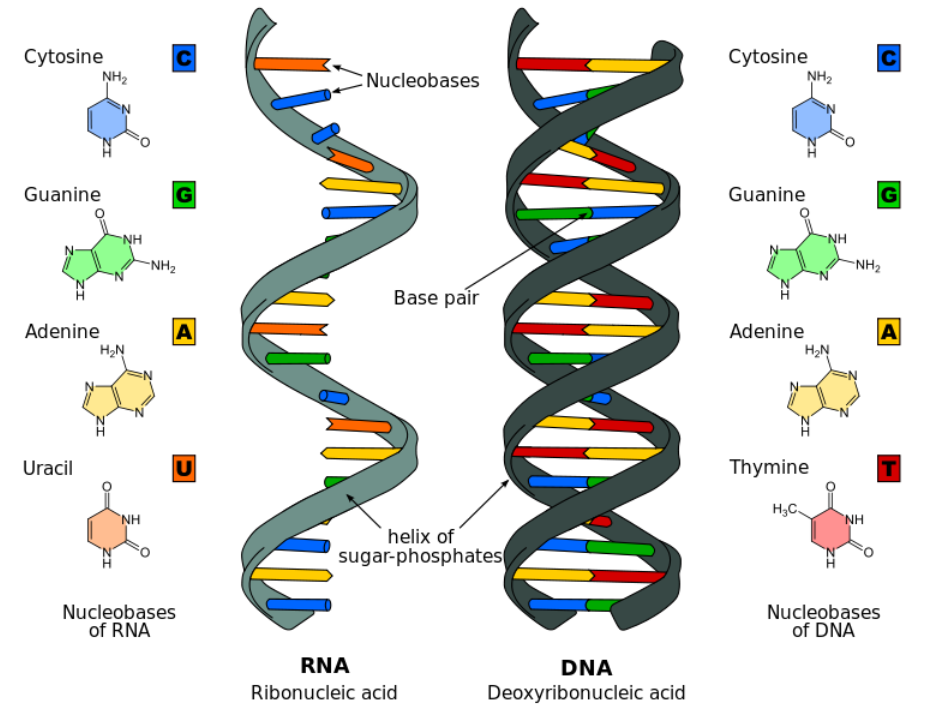
Which molecule binds to Uracil in RNA?
A. Thymine
B. Guanine
C. Cytosine
D. Adenine
E. Uracil
Answer
403.5k+ views
Hint: RNA stands for Ribonucleic acid. It contains nitrogenous bases Adenine, guanine, cytosine and uracil. The Uracil is replaced by thymine in case of DNA.
Complete Answer-
RNA is the important nucleic acid which is made up of ribose sugar, nitrogenous bases and phosphate. The main function of RNA is to bring about protein synthesis.
Let us discuss the structure of RNA-
Ribose sugar- It is a 5- carbon ring structure to which the nitrogenous bases are attached. The nitrogenous bases are attached to the pentose sugar with the help of a phosphodiester bond.
Nitrogenous bases- The RNA is made up of nitrogenous bases: Purine- Adenine, guanine, pyrimidine bases-cytosine and uracil. They play an important role in building the amino acid. The basis for the purine and pyrimidine base complements. Adenine complements with the uracil and guanine complements with the cytosine. This base pairing helps in forming the ladder-like structure in nucleic acid. The pairing of the nitrogen bases involves the formation of a double hydrogen bond between A- U and triple hydrogen bonds between C-G.
Phosphate- The 5’ end is attached with the phosphate group.

In case of DNA the uracil is replaced by thymine and the base pairing occurs between the Adenine and Uracil.
Hence the correct answer is option D.
Note –
Uracil is the demethylated form of thymine. Uracil and a naturally occurring pyrimidine derivative. Uracil requires lesser energy during its production as compared to thymine. Uracil is produced by the degradation of cytosine.
Complete Answer-
RNA is the important nucleic acid which is made up of ribose sugar, nitrogenous bases and phosphate. The main function of RNA is to bring about protein synthesis.
Let us discuss the structure of RNA-
Ribose sugar- It is a 5- carbon ring structure to which the nitrogenous bases are attached. The nitrogenous bases are attached to the pentose sugar with the help of a phosphodiester bond.
Nitrogenous bases- The RNA is made up of nitrogenous bases: Purine- Adenine, guanine, pyrimidine bases-cytosine and uracil. They play an important role in building the amino acid. The basis for the purine and pyrimidine base complements. Adenine complements with the uracil and guanine complements with the cytosine. This base pairing helps in forming the ladder-like structure in nucleic acid. The pairing of the nitrogen bases involves the formation of a double hydrogen bond between A- U and triple hydrogen bonds between C-G.
Phosphate- The 5’ end is attached with the phosphate group.

In case of DNA the uracil is replaced by thymine and the base pairing occurs between the Adenine and Uracil.
Hence the correct answer is option D.
Note –
Uracil is the demethylated form of thymine. Uracil and a naturally occurring pyrimidine derivative. Uracil requires lesser energy during its production as compared to thymine. Uracil is produced by the degradation of cytosine.
Recently Updated Pages
Master Class 12 Economics: Engaging Questions & Answers for Success

Master Class 12 Maths: Engaging Questions & Answers for Success

Master Class 12 Biology: Engaging Questions & Answers for Success

Master Class 12 Physics: Engaging Questions & Answers for Success

Master Class 12 Business Studies: Engaging Questions & Answers for Success

Master Class 12 English: Engaging Questions & Answers for Success

Trending doubts
Which are the Top 10 Largest Countries of the World?

a Tabulate the differences in the characteristics of class 12 chemistry CBSE

Why is the cell called the structural and functional class 12 biology CBSE

Differentiate between homogeneous and heterogeneous class 12 chemistry CBSE

Derive an expression for electric potential at point class 12 physics CBSE

What is the Full Form of PVC, PET, HDPE, LDPE, PP and PS ?




